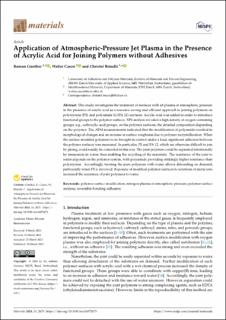Please use this identifier to cite or link to this item:
https://doi.org/10.21256/zhaw-27573| Publication type: | Article in scientific journal |
| Type of review: | Peer review (publication) |
| Title: | Application of atmospheric-pressure jet plasma in the presence of acrylic acid for joining polymers without adhesives |
| Authors: | Günther, Roman Caseri, Walter Brändli, Christof |
| et. al: | No |
| DOI: | 10.3390/ma16072673 10.21256/zhaw-27573 |
| Published in: | Materials |
| Volume(Issue): | 16 |
| Issue: | 7 |
| Page(s): | 2673 |
| Issue Date: | 28-Mar-2023 |
| Publisher / Ed. Institution: | MDPI |
| ISSN: | 1996-1944 |
| Language: | English |
| Subjects: | Polymer surface modification; Adhesion; Nitrogen plasma at atmospheric pressure; Reversible bonding; Polymer surface analysis |
| Subject (DDC): | 660: Chemical engineering |
| Abstract: | This study investigates the treatment of surfaces with jet plasma at atmospheric pressure in the presence of acrylic acid as a resource-saving and efficient approach to joining polymers on polystyrene (PS) and polyamide 12 (PA 12) surfaces. Acrylic acid was added in order to introduce functional groups to the polymer surfaces. XPS analysis revealed a high density of oxygen-containing groups, e.g., carboxylic acid groups, on the polymer surfaces, the detailed composition depending on the polymer. The AFM measurements indicated that the modification of polyamide resulted in morphological changes and an increase in surface roughness due to polymer recrystallization. When the surface-modified polymers were brought in contact under a load, significant adhesion between the polymer surfaces was measured. In particular, PS and PA 12, which are otherwise difficult to join by gluing, could readily be connected in this way. The joint polymers could be separated intentionally by immersion in water, thus enabling the recycling of the materials. The resistance of the joint to water depends on the polymer system, with polyamide providing strikingly higher resistance than polystyrene. Accordingly, treating the joint polymers with water allows debonding on demand, particularly when PS is involved. Exposure of modified polymer surfaces to solutions of metal ions increased the resistance of joint polymers to water. |
| URI: | https://digitalcollection.zhaw.ch/handle/11475/27573 |
| Fulltext version: | Published version |
| License (according to publishing contract): | CC BY 4.0: Attribution 4.0 International |
| Departement: | School of Engineering |
| Organisational Unit: | Institute of Materials and Process Engineering (IMPE) |
| Appears in collections: | Publikationen School of Engineering |
Files in This Item:
| File | Description | Size | Format | |
|---|---|---|---|---|
| 2023_Guenther-etal_Atmospheric-pressure-jet-plasma-application-acrylic-acid.pdf | 4.34 MB | Adobe PDF |  View/Open |
Show full item record
Günther, R., Caseri, W., & Brändli, C. (2023). Application of atmospheric-pressure jet plasma in the presence of acrylic acid for joining polymers without adhesives. Materials, 16(7), 2673. https://doi.org/10.3390/ma16072673
Günther, R., Caseri, W. and Brändli, C. (2023) ‘Application of atmospheric-pressure jet plasma in the presence of acrylic acid for joining polymers without adhesives’, Materials, 16(7), p. 2673. Available at: https://doi.org/10.3390/ma16072673.
R. Günther, W. Caseri, and C. Brändli, “Application of atmospheric-pressure jet plasma in the presence of acrylic acid for joining polymers without adhesives,” Materials, vol. 16, no. 7, p. 2673, Mar. 2023, doi: 10.3390/ma16072673.
GÜNTHER, Roman, Walter CASERI und Christof BRÄNDLI, 2023. Application of atmospheric-pressure jet plasma in the presence of acrylic acid for joining polymers without adhesives. Materials. 28 März 2023. Bd. 16, Nr. 7, S. 2673. DOI 10.3390/ma16072673
Günther, Roman, Walter Caseri, and Christof Brändli. 2023. “Application of Atmospheric-Pressure Jet Plasma in the Presence of Acrylic Acid for Joining Polymers without Adhesives.” Materials 16 (7): 2673. https://doi.org/10.3390/ma16072673.
Günther, Roman, et al. “Application of Atmospheric-Pressure Jet Plasma in the Presence of Acrylic Acid for Joining Polymers without Adhesives.” Materials, vol. 16, no. 7, Mar. 2023, p. 2673, https://doi.org/10.3390/ma16072673.
Items in DSpace are protected by copyright, with all rights reserved, unless otherwise indicated.